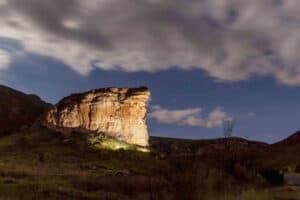The public can aid in park conservation efforts by reporting observations and volunteering to digitise data using certain platforms.

Members of the public might visit a national park and notice storm damage to a road or path, or that something in their accommodation which needs to be maintained.
Some might be aware of the toll that government budget cuts and the Covid pandemic have been having on protected areas.
The plight of provincial reserves was highlighted this year with the release of a report prepared by the Endangered Wildlife Trust.
The report emphasises the inability of provincial reserves to undertake basic conservation operations and protect biodiversity.
WATCH: Devasting Mabalingwe Game Reserve fire contained
Although South African National Parks (SANParks) and Cape Nature do generate some of their own income, this is not sufficient to meet all their operational needs for effective conservation.
For example, even after cost curtailment, SANParks reported budget deficits of R223 million in 2021-22. Before the pandemic, substantial budget cuts were already affecting conservation authorities and their operations.
The lack of income from tourism during the pandemic made this situation substantially worse, with recruitment freezes and the halting of many operations.
Tourism has been recovering but that income is insufficient to cover conservation operations. There have been further government budget cuts, restricting staff recruitment and operational budgets, meaning less staff on the ground and less conservation work being done.
While the public is aware of maintenance issues that are easy to see while out hiking or visiting park facilities, there is perhaps less awareness about important conservation functions that the public don’t usually see.
ALSO READ: River runs through Sibuya Game Reserve
Biodiversity monitoring is one of these. The SANParks honorary rangers and other volunteers do an excellent job of assisting with tasks, such as path and infrastructure maintenance, and their assistance is invaluable to an organisation that is understaffed and underfunded.
The public and SANParks staff can further contribute to effective conservation management. Conserving biodiversity requires knowing what plants and animals are in a protected area and where they are.
In the past, conservation staff made lists of species based on what they had seen themselves, what researchers had found during their studies and what specimens botanists and zoologists had deposited in herbaria and museums.
Budget constraints mean less staff and less time researching and monitoring plants and animals in national parks, so SANParks has started using sources of data that are available online.
The Global Biodiversity Information Facility provides data from sources globally, including herbariums, museums, plant, bird and butterfly projects, citizen science projects and research projects.
While much of the data from the past was based on preserved specimens, contemporary data comprises large volumes of machine observations in the form of photographs from citizen science platforms, such as iNaturalist, and camera traps and videos from baited remote underwater video systems.
ALSO READ: Elephant shot eight times during ‘unlawful’ hunt at Limpopo game reserve
There are three main ways citizens, researchers and conservation organisation staff can contribute to conservation through the use of technology.
Citizen science platforms such as iNaturalist can be used to record observations of plants and animals through photographs and audio recordings.
Citizens can also volunteer to digitise data, such as scanned or photographed herbarium specimen voucher records, using platforms, such as DigiVol.
They can also identify species and behaviours in camera trap photographs and videos on platforms, such as Zooniverse.
SANParks scientists conduct considerable conservation research and monitoring work, which can be read about in its annual research reports and blogs.
ALSO READ: Kruger Park beefs up security at Numbi Road after killing of German tourist
Everyone can help scientists and conservation staff in conducting their important work in national parks and other protected areas to achieve better conservation outcomes.
When you’re next in a protected area and see or hear something new or interesting, get out your phone or camera and take a photo or record some audio to put on iNaturalist.
Spear is the bioinformatics and science manager, Scientific Services: Cape Research Centre, South African National Parks






